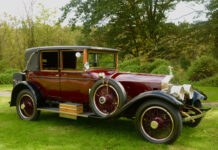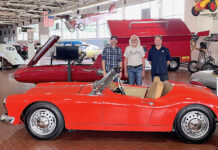By Jay Hirsch
Rust Heinz was an heir to the Heinz family food empire of Pittsburgh, Pa. Rust had a background designing racing boats, and the with the considerable wealth of his family, 21-year-old Rust had the Pasadena, Cali., coach-building firm Bowman & Schwartz build this car. A custom-built 1936 Cord 810 chassis was used with the power coming from the Cord’s Lycoming V-8 engine.
Bowman & Schwartz used the Cord 810 front-wheel drive chassis and the Lycoming V-8 engine with electric shifting that was modified in Andy Granatelli’s shop. With a chrome-moly chassis, no visible handles, no running boards — or really any fenders to speak of — the sleek drawings of Rust were made into aluminum and steel. His design was developed with clay models and home-made wind tunnels, and the Corsair was certainly on the leading edge of automobile aerodynamics. It’s heavily-padded and cork-lined passenger compartment was quite futuristic with safety in mind. The Corsair had four-across seating in front (one person sat to the left of the driver), and there was bullet-proof glass for safety. The back seats were for two people only, due to the space for cabinets that were for “on board beverages.”
The Corsair was a wonderful combination of extraordinary design and complete impracticality.
The Phantom Corsair was a “prototype,” a two-door, six-passenger automobile constructed of aluminum and steel. It is 57 inches tall, which in 1938 was at least seven inches lower than most cars of the period. The Corsair measured 237 inches in length, was 76.5 inches wide, and weighed 4,600 pounds, riding on a wheelbase of 125 inches. It is said it could reach a speed of 115 mph.
To go along with the smoothness of its design the Corsair had no door handles. In place of door handles there was a push button above the belt line to the rear of the door in the roof that was electrically operated. There was also a push button on the dash to open the doors when seated inside. The instrument panel had warning lights to indicate if a door was not completely closed or if the car’s lights were on.
In 1938 the Corsair appeared in the movie “Young at Heart” produced by David O Selznick. The Corsair was called the “Flying Wombat” in the movie (a wombat is mole-like animal found in Australia). David also produced another movie in 1938 — “Gone With The Wind.”
In 1947 the Corsair was purchased by collector Richard Rush for $5,000. Four years later in 1951 Rush sold the car to Los Angeles radio and television personality Herb Shriner. Shriner had the car repainted and hired Albrecht Goetz to redesign the front of the car to allow more air flow for cooling the V-8 engine. This meant opening the front which altered the original design. Goetz also designed the 1957 BMW 507. The redesigned Corsair was displayed at the 1954 New York Auto show with Herb Shriner and was now painted yellow and red.
William Harrah acquired the Corsair in the 1970s and had the car restored back to its original design. The Phantom Corsair currently resides in the National Automobile Museum (the former Harrah Collection) in Reno, Nev.
Rust Heinz planned to put the Phantom Corsair (which cost approximately $24,000 to produce in 1938, which is about $370,000 today) into limited production at an estimated selling price of $12,500. However, Heinz’s death in a car accident in July 1939 ended those plans, leaving the prototype Corsair as the only one ever built.
Rust was killed July 24, 1939. His friend Phil Brainard was driving Rust’s four door Buick convertible in Wilkinsburg, Pa. The Buick was broadsided by another vehicle, and Rust died from head injuries. •



